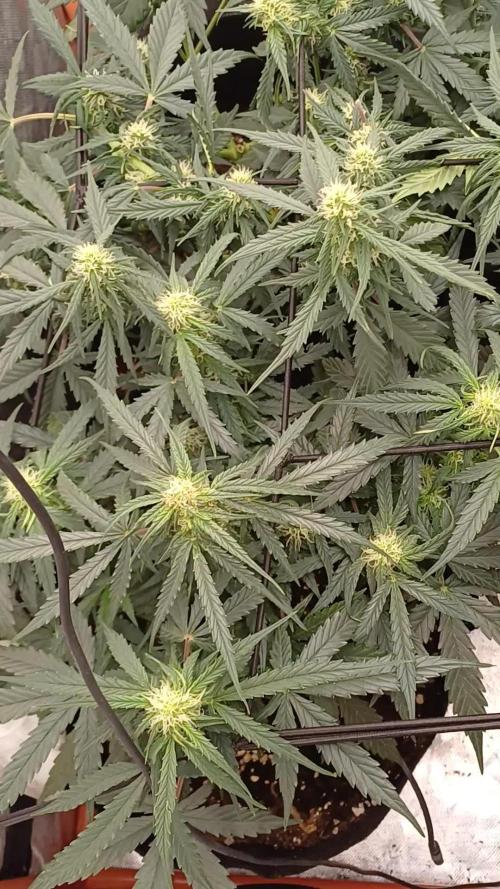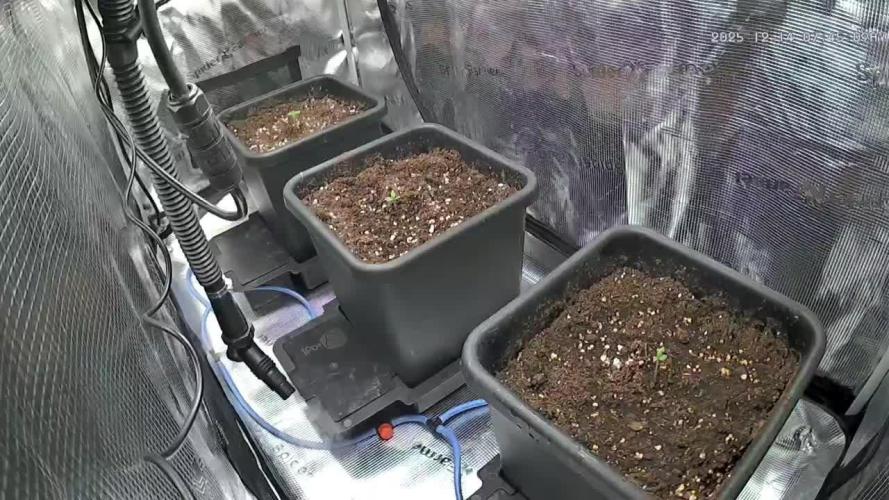The Grow Awards 2026 🏆 





































Likes
Comments
Share


@GasStation420
Follow
Smell is getting intense..sweet bud when closer inpection the smell is smelling like something that will make u nauseous yet intriguing...smelling like mushrooms alil and definitely garlic 🤢 ...
Can't wait to test this baby and her taste profile
Likes
9
Share


@Enochian
Follow
Another good week in the garden. Weather outside has turned cooler and wet but tent keeps an even 25c at 60 RH and smells great! I keep making excuses to put my head in n take a big breath. They still taking water every morning and dry within 24 hrs but I think she is starting to slow down now. Pistills turning darker and buds getting sticky n fat. Bit of frosting on the topmost sugar leaves and are beginning to fade in colour. Cleaning my loupe ready for next week. Titan is doing great too, can't wait for her to have the tent to herself and see what she can do.
Likes
13
Share


@Hroma
Follow
Semana del 4 al 10 Marzo
Semana 9 Floración
Abonado Floración (Top Bud) —
— Pineapple
— Franco's Lemon Cheese
— American Purple
Final Solution —
— Razuberi
— Critical 2.0
— Liberty Haze
— White Widow
— DC Kush
Processing
Likes
10
Share


@CanadianFillmore
Follow
Week 3 flowering begins! Added B52 to the nute mix this week. Green Crack is looking healthy and she stretched a lot the last week.
Thanks for stopping by 👽🌳💚
Likes
1
Share


@TellerrandGesprengt
Follow
Nachdem ich die ersten Samen fachgerecht hingerichtet habe, starte ich jetzt einen neuen Run – diesmal mit deutlich mehr Lebenszeichen.
Likes
6
Share


@Guinha_s2
Follow
Não coloquei muitos nutriente essa semana, está linda e resinando muito, as vezes deixo no sol por umas 2/3 horas
Likes
5
Share


@Xipsiomega1
Follow
End of 6th week (day 42) in bloom. Plants have stopped growing in height. Colas are filling fast so i put some big sticks to stabilize them and avoid crushing down from weight. One of nine plants is about 10 days back in bloom as it started to show signs of sex in day 20 after i changed the light circle! No nutrients this week and generally i don;t feed much. I do some light feeding mostly weeks 1-4 in bloom. I mix some bio nutrients in the soil (light mix) before transplant. These strains are 100% sativas and need low N and moderate P/K
Likes
24
Share


@Jays_Not_Here_Man
Follow
The girls have survived another week ❤️ I did a light defoliation and have been monitoring the RH closely. We have had a very damp week here, and the RH kept climbing and had my fan working hard.
They are starting to plump up and fill in 😋. They have also started to slow their drinking habits, instead of watering every three days, it has moved to every 4 now. Just a couple of weeks left, I think I will be harvesting these over Christmas 🎄, and will have some great bud ready for the new year! 🎉🎊🍾
Likes
80
Share


@RickJames_Mcdank
Follow
Everything is going fine so far.
And the smell is just amazing and the trichomes are growing good and allot.
By the looks of it its all going how it supposed to grow.
I started this week with lowering the nutrients from 4 ml to 3 ml.
Upcoming week I will start to flush till harvest time.
Oh yeah can't wait to taste and get high from my own grow.
😍😀
Likes
29
Share


@Gilgamesh15
Follow
-Godetevi il video della presentazione del locale di coltivazione!!!!
-Problema calo PH in stabilizzazione.
-Continua problema di ingiallimento foglie a ventaglio!?!
-Mainlining e manifold in crescita.
-Il controller CO2 Evolution della Etechnics funziona male (fa svuotare la bombola).
Processing
Likes
12
Share


@chrisss
Follow
Heating Mat to keep temp in 80’s
Day15)( Week 3 Day1) No water,good Added Mushie Man
Day 16) idk if I’m right but growth seems a lil slow hopefully nothings wrong
Day 18) Added c02 yesterday night , gonna put the lights at 50 watts
Day19) Feeding stronger, keep bringing light up more as the plant grows so it’s 30 inches above the plant
Day20) GROWTH IS AMAZING , idk if it’s the co2 or it’s just getting older, prolly both either way it’s great news, moving light up more, I’ll start LST on Sunday which is day 22, cleaning fan cause of humidifier ( tap water), keep humidity in high 50s and temp above 80 , for humidity reasons I only turn on in-line fan for a couple hours some afternoons
Day 21) Fed Calmag, grow and micro to tap water(PH 6.2), added more coco to the top,will LST tmrw
Processing
Likes
10
Share


@btcywtsitw
Follow
So I definitely fucked up this week and missed some crucial water times. I passively knew in the back of my mind to but I was just having busy and stressful days.
Likes
6
Share


@GoldenWeedGrower
Follow
Legend
Timestamp: 📅
EC - pH: ⚗️
Temp - Hum: 🌡️
Water: 🌊
Food: 🍗
pH Correction: 💧
Actions: 💼
Thoughts: 🧠
Events: 🚀
Media: 🎬
D: DAY, G: GERMINATION, V: VEGETATIVE, B: BLOOMING, R: RIPENING, D: DRYING, C: CURING
______________
📅 D29/V25 - 14/05/24
⚗️ EC: 1.0 pH: 5.2
🌡️ T: 20°C H: 50%
🌊
🍗
💧
💼
🧠
🚀 Back Home
🎬
______________
📅 D30/V26 - 15/05/24
⚗️ EC: 1.0 pH: 5.0
🌡️ T: 20°C H: 50%
🌊
🍗
💧
💼
🧠
🚀
🎬 1 TL video
______________
📅 D31/V27 - 16/05/24
⚗️ EC: 1.2 pH: 5.0
🌡️ T: 20°C H: 60%
🌊
🍗
💧
💼
🧠
🚀
🎬 1 TL video very short + 1 TL video of LST
______________
📅 D32/V28 - 17/05/24
⚗️ EC: 1.2 pH: 5.0
🌡️ T: 20°C H: 60%
🌊
🍗
💧
💼
🧠
🚀
🎬 1 TL video
______________
📅 D33/V29 - 18/05/24
⚗️ EC: 1.2 pH: 5.0
🌡️ T: 20°C H: 60%
🌊
🍗
💧
💼
🧠
🚀
🎬 1 TL video
______________
📅 D34/V30 - 19/05/24
⚗️ EC: 1.0 pH: 5.0
🌡️ T: 20°C H: 60%
🌊
🍗
💧
💼 Big work to prepare her new home
🧠
🚀
🎬
______________
📅 D35/V31 - 20/05/24
⚗️ EC: 1.0 pH: 6.0
🌡️ T: 20°C H: 70%
🌊 16 L
🍗 CalMag - Grow A-B, B-52, Bud Candy, Rhino Skin, Hydroguard
💧
💼
🧠
🚀 The new home for Rey in now ready
🎬
Likes
82
Share


@Fatnastyz
Follow
4-5
Harvested finally, well finally for me. 😂
Big ol, stinky and sticky buds. Density is not an issue! 💪😂
Loved this grow! Went really smooth, with me freaking out occasionally 😂
No over/under water and no over feed!
FINALLY!!!
Wow met lots of new and great people this grow! You people in this community rock! 💚
Now enough of the mushy stuff.
Guy says once dried, we should have right around 3 ounces. Lets see how good his guesstimate is.
🙏🙏💪😁😻🤘
Likes
3
Share


@mistaminista420
Follow
So I had to cut all leaves, and also some of the smaller leaves due to mold. It was only a little bit mold but I cut away every part that seemed to white for me in the end. It probably would habe worked out growing her 2-3 weeks longer but I decided to chop/save her.
Likes
9
Share


@my420experiment
Follow
Learning a ton as I go.
Started low stress training using rubberized wire poked down into the soil.
Spent a lot of time just tucking the fan leaves down.
I'm an idiot when it comes to watering.
I dont think I'm getting enough down to the bottom of the pot, but dont want to over water.
I'll just continue with what I'm doing.
Likes
28
Share


@rainman
Follow
Second week of flowering, done some defoliation. Happy I found Terpinator in my country, let's see how it changes final result.
Day 64 - 4L with recharge.
Day 68 - 4L with nutrients.
Peace.
Likes
9
Share


@Garamantes
Follow
After 3 days, when the temperature rose above 11 degrees, I could finally remove the greenhouse from the pet bottle.
I did the first fertilizing with Advanced nutrients Voodoo juice, Piranha and Tarantula for better development and protection of the root.
Unfortunately, the pet bottle greenhouse, which was dewy and dirty from snail slime, caused the main stem to pull out more than I would have liked.
I like it when the main stem is low and immediately starts to form secondary branches
Likes
12
Share


@RookieGrowerTH
Follow
Week 3 from seed, 1st week of Veg. Transplant to a 5-gallon fabric pot, they will grow in living soil and set up auto drip irrigation by using Netafim Netbow.

























